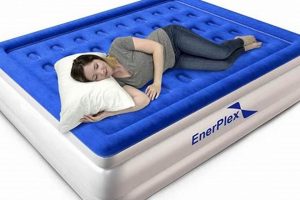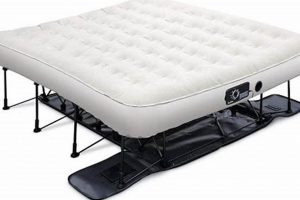The procedure involves removing air from a specific type of inflatable sleeping surface manufactured by Intex. This process prepares the mattress for storage or transportation. Failure to execute the procedure properly may result in damage to the mattress or difficulty in subsequent inflation.
Efficient air removal is crucial for extending the lifespan of the product. It allows for compact storage, minimizing the space required when the mattress is not in use. Historically, deflation methods have evolved from simple valve releases to incorporate more sophisticated mechanisms for expediting the process and ensuring thorough air expulsion. This contributes to user convenience and the overall practicality of the inflatable mattress.
The following sections will detail the various techniques available for conducting this procedure, including methods for mattresses with and without built-in pumps, as well as tips for achieving complete deflation.
Optimizing Air Removal from Intex Mattresses
Effective air expulsion from Intex air mattresses is essential for proper storage and longevity. The following guidelines outline best practices for achieving thorough deflation.
Tip 1: Locate and Open the Primary Valve. The primary valve is typically a large opening designed for rapid deflation. Ensure the valve is fully unobstructed for maximum airflow.
Tip 2: Apply Body Weight Strategically. Distribute weight evenly across the surface of the mattress to force air towards the open valve. Focus pressure on areas furthest from the valve.
Tip 3: Utilize a Vacuum Cleaner (with caution). A vacuum cleaner, set to exhaust, can be attached to the valve (if compatible) to draw air out. Monitor the mattress closely to prevent over-deflation and potential damage.
Tip 4: Employ Rolling and Folding Techniques. Once the initial air volume has been reduced, tightly roll the mattress from the end opposite the valve. Secure the rolled mattress with straps or ties to prevent re-inflation during storage.
Tip 5: Check for Secondary Valves or Plugs. Some models feature additional valves or plugs intended for fine-tuning inflation or deflation. Ensure these are also opened to facilitate complete air removal.
Tip 6: Ensure a Clean Environment. Deflate the mattress on a clean, smooth surface to prevent punctures or tears during the process.
Consistent application of these methods will significantly improve the efficiency of air expulsion, resulting in easier storage and minimizing the risk of damage.
The subsequent section will address common issues encountered during air removal and offer troubleshooting solutions.
1. Valve Location
The process depends fundamentally on identifying the valve’s position. This component serves as the egress point for air, and without locating it, deflation cannot commence. Valve designs vary across Intex mattress models; some employ a single, large-diameter valve for rapid expulsion, while others integrate a two-part system with a smaller valve for fine-tuning. Misidentifying the valve can lead to attempts at deflation through incorrect points, potentially causing damage or prolonging the process unnecessarily. For example, attempting to deflate the mattress through an inflation-only port will prove ineffective.
Knowing the valve’s specific type and location directly impacts the method employed for deflation. A large, single-valve system often allows for simple manual deflation by opening the valve and applying pressure to the mattress. Conversely, a mattress with a two-part valve may require a specific tool or the use of an external pump to effectively initiate and accelerate the process. Many users struggle with mattresses featuring recessed valves, failing to fully expose the opening for optimal air flow. This highlights the practical significance of a clear understanding of valve design and placement.
In summary, valve location is not merely a preliminary step but an integral determinant of deflation efficiency and effectiveness. Accurately identifying and understanding the valve’s characteristics is vital for a streamlined process, preventing potential damage and ensuring proper mattress preparation for storage or transport. Disregarding this foundational element can result in unnecessary difficulties and potentially compromise the mattress’s integrity.
2. Air expulsion method
The air expulsion method is a critical determinant of the efficiency and effectiveness of air mattress deflation. The choice of technique directly influences the speed, thoroughness, and potential for damage during the process of preparing an Intex air mattress for storage or transport.
- Manual Compression and Rolling
This fundamental method relies on physically applying pressure to the mattress to force air out through the valve. Rolling the mattress from one end toward the valve concentrates pressure, maximizing expulsion. Inefficiencies arise if pressure is unevenly applied or if the valve is not fully open. For instance, neglecting to properly roll the mattress often leaves pockets of air trapped inside.
- Integrated Pump Reverse Function
Certain Intex air mattresses feature integrated pumps capable of reversing airflow to extract air. This method generally offers greater speed and efficiency compared to manual compression. However, its effectiveness depends on the pump’s power and the seal between the pump and the valve. A weak pump or a compromised seal can significantly reduce air extraction, necessitating supplementary manual effort.
- External Vacuum Adaptor
An external vacuum cleaner, when used with an appropriate adaptor, can create a powerful suction force to rapidly evacuate air. The key advantage is speed, but caution must be exercised to avoid overheating the vacuum or damaging the mattress valve. Some users have reported valve deformation due to excessive suction, highlighting the need for careful monitoring and controlled application.
- Gravity Assisted Deflation
Elevating the mattress with the valve positioned downwards harnesses gravity to assist in air removal. This approach is typically used in conjunction with other methods. The force of gravity aids in directing air towards the valve, promoting a more complete evacuation, particularly in mattresses with complex internal structures. Leaving the mattress vertically positioned with the valve open overnight can further enhance this process.
The selection and proper application of an air expulsion method are paramount for successful deflation. While manual compression remains a viable option, integrated pumps and external vacuums offer enhanced speed and efficiency. Understanding the nuances of each method, including their limitations and potential ris
ks, ensures a streamlined and effective deflation process, minimizing the risk of damage and optimizing the mattress for storage.
3. External pump usage
The utilization of an external pump presents a significant variable in the process. The device’s capabilities and the operator’s technique directly influence the speed, thoroughness, and potential risks associated with air expulsion.
- Pump Compatibility and Valve Adaptors
The effectiveness of an external pump hinges on compatibility with the Intex mattress valve. Universal adaptors are available, but their seal integrity varies. A loose or ill-fitting adaptor diminishes suction power, prolonging deflation. Some pumps, designed for higher volumes but lower pressure, are less efficient than those tailored for inflatable products. Selection of an appropriate adaptor and pump type is critical for optimized performance.
- Directional Functionality: Inflation vs. Deflation
Most external pumps offer bidirectional airflow, capable of both inflating and deflating. Incorrectly setting the pump to inflation will exacerbate the situation. Users must ensure the pump is configured for deflation mode. This selection is typically controlled by a switch or valve on the pump body. A misconfigured pump can result in the mattress becoming more inflated rather than deflated.
- Potential for Overheating and Valve Damage
Prolonged use of an external pump can lead to overheating, both within the pump itself and within the mattress valve. The friction generated by rapid airflow can deform or melt the valve material, rendering it ineffective. Regular monitoring of the pump’s temperature and brief pauses during the process can mitigate this risk. The use of lower power settings, where available, can also reduce heat generation.
- Achieving Near-Complete Air Removal
While external pumps expedite the initial deflation phase, achieving near-complete air removal often requires supplementary techniques. Rolling the mattress while the pump operates, or after its initial use, helps force residual air towards the valve. An external pump, though efficient, may not evacuate all air trapped within the mattress’s internal structure, thus necessitating further manual intervention for optimal storage.
In summary, the strategic deployment of an external pump is a valuable tool. However, effective application requires careful consideration of pump compatibility, directional settings, overheating risks, and the need for supplementary manual techniques to achieve thorough air expulsion. Proper handling and awareness of these factors optimize the process.
4. Rolling technique
The rolling technique is a fundamental component of the process. Its correct application directly influences the degree of air expulsion achievable, thus affecting the final packed size and long-term storage condition of the mattress.
- Initiation Point and Direction
Rolling should commence at the end opposite the valve, progressing systematically towards the valve opening. Incorrect initiation leads to air being trapped within the rolled mattress. A real-world example is attempting to roll from the middle, creating air pockets that resist compression and hinder full deflation. Consistent unidirectional rolling ensures that air is progressively forced towards the exit point.
- Maintaining Consistent Pressure
Uniform pressure during rolling is crucial for effective air displacement. Uneven pressure results in localized air pockets and an irregular mattress shape. Consider the scenario where pressure is only applied to the edges; the central area remains inflated, preventing compact storage. A steady, even application of force across the entire width of the mattress ensures consistent deflation.
- Valve Position and Optimization
Ensuring the valve is fully open and unobstructed throughout the rolling process is essential. Partial obstruction restricts airflow, reducing the effectiveness of the technique. An example is a valve partially covered by the mattress material, impeding air expulsion. Regular checks and adjustments to the valve position during rolling optimize air removal.
- Securing the Deflated Mattress
Following complete rolling, securing the mattress with straps or ties prevents re-inflation. Failure to secure the mattress allows residual air pressure to gradually expand it, negating the effects of the rolling process. Imagine rolling the mattress meticulously, only to have it partially re-inflate due to the lack of securing straps. Secure fastening maintains the compact state achieved through rolling.
The rolling technique, when executed correctly, facilitates efficient and thorough deflation. Ignoring any of its facets can undermine the entire process, leading to storage inefficiencies and potential mattress damage. The interplay of these elements underscores the technique’s integral role in proper handling and preservation of the product.
5. Complete air removal
Achieving complete air removal represents the culminating objective. Its realization determines the efficiency of storage, minimizes potential material degradation, and ensures the mattress is suitably prepared for subsequent use. The process involves more than merely opening the valve; it demands a systematic approach to expelling residual air.
- Minimizing Storage Volume
Complete air expulsion directly correlates to reduced storage volume. Residual air increases the bulk of the mattress, requiring more storage space and potentially subjecting the material to unnecessary stress. A mattress with significant air pockets occupies substantially more volume than one fully deflated. Minimizing the stored volume simplifies handling and conserves storage space.
- Preventing Material Degradation
Residual air contributes to material degradation over extended storage periods. Fluctuations in temperature and atmospheric pressure cause the trapped air to expand and contract, stressing the mattress seams and internal structure. Repeated stress weakens the material, increasing the likelihood of leaks and premature failure. Thorough air removal minimizes internal pressure variations, prolonging the mattress’s lifespan.
- Ensuring Optimal Re-Inflation
The degree of air expulsion influences the ease and effectiveness of subsequent re-inflation. Residual air hinders uniform inflation, potentially leading to uneven pressure distribution and discomfort. A partially inflated mattress, retaining air from previous use, may not fully conform to its intended shape upon re-inflation. Complete deflation ensures a consistent and optimal inflation process.
- Facilitating Damage Inspection and Repair
A fully deflated mattress allows for easier and more thorough inspection for potential damage. Air pockets conceal tears, punctures, and seam weaknesses. Deflation allows the material to lie flat, exposing imperfections that might otherwise remain undet
ected. Early detection of damage facilitates timely repairs, preventing further deterioration and extending the mattress’s usability.
These facets underscore the importance of achieving complete air removal. While the initial deflation process may appear straightforward, the commitment to thoroughness ensures long-term preservation and functionality. Failing to prioritize complete air removal negates the benefits of careful deflation and storage practices, ultimately compromising the mattress’s integrity and lifespan.
6. Storage readiness
Preparation for storage constitutes the final phase in the air mattress handling protocol. This stage directly affects the longevity of the product and its performance upon subsequent use. The effectiveness of the deflation process fundamentally determines the mattress’s readiness for secure and space-efficient storage.
- Moisture Mitigation and Material Preservation
Prior to storage, any residual moisture must be eliminated. Dampness encourages mold growth and material degradation, particularly in humid environments. Air drying the mattress following deflation, or employing a desiccant during storage, prevents these issues. Failure to address moisture can lead to irreversible damage, rendering the mattress unusable. Thorough drying complements air expulsion in preserving the product.
- Folding and Protection Against Puncture
The folding method employed during storage impacts material stress and puncture risk. Avoid sharp creases and tight folds that concentrate pressure on specific areas. Protect the mattress with a storage bag or wrap to shield it from dust, debris, and potential punctures. Improper folding and inadequate protection significantly increase the likelihood of damage during storage. This step ensures that careful air expulsion is not undermined by negligent handling.
- Temperature Considerations and Material Elasticity
Storage temperature affects material elasticity and overall integrity. Extreme temperatures, both high and low, can compromise the mattress’s structure. Storing the mattress in a climate-controlled environment, or avoiding direct exposure to sunlight and freezing temperatures, mitigates these risks. Temperature regulation preserves the material’s flexibility and resistance to tearing, directly impacting its long-term performance.
- Securing and Preventing Re-Inflation
Effective storage requires measures to prevent re-inflation. Even with thorough air expulsion, residual air pressure can gradually expand the mattress. Securing the rolled or folded mattress with straps or ties minimizes this effect, maintaining a compact storage profile. Failure to secure the mattress negates the benefits of complete air removal, leading to increased storage volume and potential stress on the material.
These elements collectively define storage readiness. The initial deflation process, however meticulously executed, is rendered incomplete without due consideration for moisture control, protective folding, temperature regulation, and secure fastening. Neglecting these factors compromises the long-term viability and functionality of the mattress, underscoring the interdependence of all stages in the handling protocol.
7. Preventing Damage
The act of deflating an Intex air mattress, while seemingly straightforward, presents various opportunities for inflicting damage. Proper execution of deflation techniques is crucial to safeguard the mattress material and internal structure, preserving its integrity for prolonged use. The following points detail key considerations for mitigating potential harm during this process.
- Controlled Airflow and Valve Integrity
Rapid, uncontrolled air expulsion can stress the valve mechanism, potentially leading to cracks or separation. Similarly, forcing sharp objects into the valve to accelerate deflation poses a direct threat. An example is using a screwdriver to depress the valve pin, risking permanent damage. Controlled airflow, whether achieved through manual compression or an external pump, minimizes stress and preserves valve functionality.
- Surface Protection and Abrasion Reduction
Deflating a mattress on an abrasive surface, such as concrete or rough carpeting, can cause scuffing and puncture. Debris trapped between the mattress and the surface exacerbates this risk. Imagine deflating the mattress on a driveway; small stones can create micro-tears in the material. Deflating the mattress on a clean, smooth surface, or using a protective layer, reduces abrasion and the potential for puncture.
- Folding Technique and Crease Management
Improper folding practices can create sharp creases that weaken the material over time. Repeated folding along the same lines concentrates stress, increasing the likelihood of tears. A real-world example is consistently folding the mattress into a small square; the crease lines become points of vulnerability. Employing a rolling technique, or varying the folding pattern, distributes stress and minimizes the formation of damaging creases.
- Storage Environment and Material Degradation
While not directly related to the deflation process itself, the storage environment post-deflation significantly impacts the material’s long-term integrity. Exposure to extreme temperatures, direct sunlight, or moisture accelerates degradation. A deflated mattress stored in a hot attic is more prone to cracking and discoloration than one stored in a cool, dry place. Choosing a suitable storage location, shielded from environmental extremes, preserves the material’s elasticity and prevents premature failure.
These considerations highlight the interconnectedness of deflation technique and long-term mattress preservation. While efficient air expulsion is the primary goal, it must be pursued with a focus on mitigating potential damage. Implementing these preventative measures ensures the Intex air mattress remains a reliable sleeping solution for an extended period. The failure to follow them can undo otherwise proper practices.
Frequently Asked Questions
This section addresses common inquiries and concerns regarding the effective deflation of Intex air mattresses. The responses provide practical guidance and aim to clarify potential misunderstandings.
Question 1: What is the fastest method to remove air from an Intex air mattress?
The utilization of an external pump with a deflation setting, coupled with a compatible valve adaptor, generally offers the quickest air removal. Manual rolling and compression serve as supplementary techniques to expel any remaining air.
Question 2: Can a vacuum cleaner be employed to expedite deflation?
A vacuum cleaner, set to exhaust and used with a suitable adaptor, can accelerate the process. Caution is advised to prevent overheating the vacuum and avoid damaging the mattress valve due to excessive suction.
Question 3: How can one ensure complete air removal before storage?
After initial deflation using a pump or manual methods, tightly rolling the mattress from the end opposite the valve assists in expelling residual air. Securing the rolled mattress with straps maintains compression a
nd minimizes re-inflation.
Question 4: What should be done if the mattress valve appears to be blocked or malfunctioning?
Inspect the valve for any obstructions or debris. Gently cleaning the valve with a soft cloth may resolve minor blockages. If the valve is damaged, contact Intex customer support for replacement options.
Question 5: Is it necessary to dry the mattress before storage after deflation?
Yes, eliminating any residual moisture is essential. Air drying the mattress thoroughly, or using a desiccant during storage, prevents mold growth and material degradation.
Question 6: What are the optimal storage conditions for a deflated Intex air mattress?
Store the mattress in a cool, dry location, away from direct sunlight and extreme temperatures. Using a protective storage bag shields the material from dust, debris, and potential punctures.
These FAQs provide a comprehensive overview of key aspects related to Intex air mattress deflation. Adhering to these guidelines ensures efficient air removal, minimizes potential damage, and optimizes the mattress for long-term storage.
The subsequent section will summarize the key takeaways from this discussion and offer concluding remarks.
Conclusion
This exploration of how to deflate intex air mattress has outlined a comprehensive approach, encompassing valve identification, optimal air expulsion methods (manual, pump-assisted), the critical rolling technique, and the importance of achieving complete air removal. Securing the mattress for storage, minimizing moisture, and safeguarding against damage were also underscored as integral elements in the process.
Mastering these techniques ensures not only efficient storage but also prolongs the lifespan of the Intex air mattress, preserving its functionality and comfort for future use. Consistent application of these principles promotes both user convenience and the responsible stewardship of the product.







